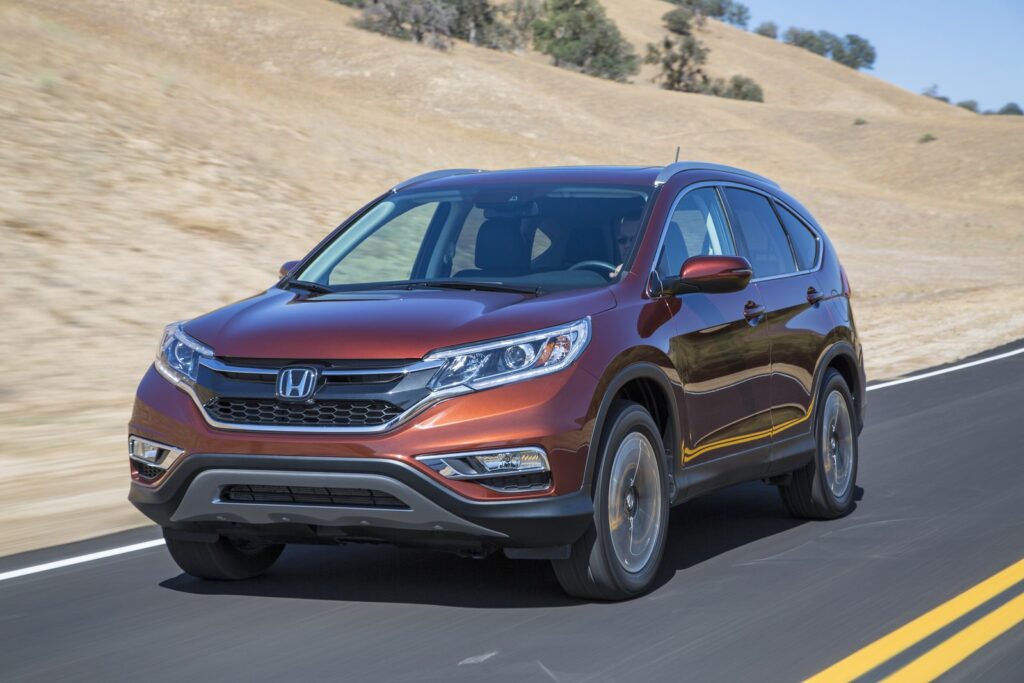Maintaining the correct tire pressure is crucial for several reasons. First, it ensures your vehicle is safe to drive, as underinflated tires can be more susceptible to punctures, blowouts, and other hazards on the road. Additionally, proper tire pressure can improve your vehicle’s fuel efficiency, reduce tire wear and tear, and provide a smoother ride.
What is the Recommended Tire Pressure for a Honda CRV?
The recommended tire pressure for a Honda CRV varies depending on the model year and tire size. You can find the correct pressure level for your specific vehicle in the owner’s manual or on the tire information placard located on the driver’s side door jamb.
As a general rule of thumb, the recommended tire pressure for a Honda CRV is typically between 32 and 35 PSI (pounds per square inch).
The recommended tire pressure by year:
| Year | Recommended Tire Pressure |
|---|---|
| 2023 | 33 PSI |
| 2022 | 33 PSI |
| 2021 | 33 PSI |
| 2020 | 32 PSI |
| 2019 | 32 PSI |
| 2018 | 32 PSI |
| 2017 | 32 PSI |
| 2016 | 32 PSI |
| 2015 | 32 PSI |
| 2014 | 32 PSI |
| 2013 | 32 PSI |
| 2012 | 30 PSI |
| 2011 | 30 PSI |
| 2010 | 30 PSI |
| 2009 | 30 PSI |
| 2008 | 30 PSI |
| 2007 | 30 PSI |
| 2006 | 30 PSI |
| 2005 | 30 PSI |
| 2004 | 30 PSI |
| 2003 | 26 PSI |
| 2002 | 26 PSI |
| 2001 | 26 PSI |
| 2000 | 26 PSI |
It’s important to note that the recommended tire pressure may vary depending on the tire size, so it’s always a good idea to check the tire information placard located on the driver’s side door jamb or consult your owner’s manual for the correct pressure level for your specific vehicle. Additionally, it’s recommended to check your tire pressure at least once a month or before long trips to ensure your vehicle is safe and performing at its best.
The recommended tire pressure for different generations
| Honda CRV Generation | Model Year Range | Recommended Tire Pressure |
|---|---|---|
| First Generation (Gen 1) | 1997 – 2001 | 26 psi (front and rear) |
| Second Generation (Gen 2) | 2002 – 2006 | 30 psi (front and rear) |
| Third Generation (Gen 3) | 2007 – 2011 | 30 psi (front) and 29 psi (rear) |
| Fourth Generation (Gen 4) | 2012 – 2016 | 32 psi (front and rear) |
| Fifth Generation (Gen 5) | 2017 – present | 33 psi (front and rear) |
Note: The recommended tire pressure may vary depending on factors such as tire size, load capacity, and driving conditions. Therefore, it is always best to refer to the owner’s manual or the tire pressure sticker on the driver’s side doorjamb for the most accurate and up-to-date information.
The recommended tire pressure by trim level
| Trim Level | Recommended Tire Pressure |
|---|---|
| LX | 32 PSI |
| EX | 32 PSI |
| EX-L | 32 PSI |
| Touring | 33 PSI |
| Hybrid LX | 33 PSI |
| Hybrid EX | 33 PSI |
| Hybrid EX-L | 33 PSI |
| Hybrid Touring | 36 PSI |
It’s important to note that the recommended tire pressure may vary depending on the tire size, so it’s always a good idea to check the tire information placard located on the driver’s side door jamb or consult your owner’s manual for the correct pressure level for your specific vehicle. Additionally, it’s recommended to check your tire pressure at least once a month or before long trips to ensure your vehicle is safe and performing at its best.
How to Check Your Honda CRV Tire Pressure
Checking your Honda CRV tire pressure is a quick and easy process that you can do at home with the right tools.
Tools Needed
- Tire pressure gauge
- Air compressor or tire inflator
- Valve stem caps
Steps to Follow
- Locate the tire information placard on your Honda CRV (usually located on the driver’s side door jamb).
- Check the recommended tire pressure for your vehicle.
- Remove the valve stem caps from the tires.
- Use the tire pressure gauge to check the pressure in each tire. Insert the gauge into the valve stem and press down firmly until the hissing sound stops. The gauge will give you a reading of the current pressure in the tire.
- Compare the tire pressure reading to the recommended pressure for your vehicle. If the pressure is too low, you will need to add air to the tire. If the pressure is too high, you will need to let air out of the tire until it reaches the correct pressure level.
- Repeat this process for each tire on your Honda CRV.

What to Do If Your Honda CRV Tire Pressure is Low
If you notice that your Honda CRV tire pressure is lower than the recommended level, it’s important to add air to the tire as soon as possible.
How to Inflate Your Tires
- Park your Honda
- Remove the valve stem cap from the tire you need to inflate.
- Attach the air compressor or tire inflator to the valve stem.
- Turn on the compressor and let it inflate the tire to the recommended pressure level.
- Use the tire pressure gauge to check the pressure level again to ensure it matches the recommended pressure.
- Repeat this process for any other tires that are low on pressure.
How to Know When Your Tires Are Full
To know when your tires are full, you can use a tire pressure gauge. Once the pressure reading matches the recommended pressure for your Honda CRV, you can stop inflating the tire. Alternatively, some air compressors or tire inflators have an automatic shut-off feature that will stop inflating the tire once it reaches the desired pressure level.
What to Do If Your Honda CRV Tire Pressure is High
If you notice that your Honda CRV tire pressure is higher than the recommended level, you will need to let air out of the tire until it reaches the correct pressure level.
How to Deflate Your Tires
- Remove the valve stem cap from the tire you need to deflate.
- Use the tire pressure gauge to check the current pressure level.
- Press the valve stem down to release air from the tire. You can use the tire pressure gauge to check the pressure level periodically until it reaches the recommended level.
- Repeat this process for any other tires that are high on pressure.
How to Know When Your Tires are at the Right Pressure
To know when your tires are at the right pressure, use a tire pressure gauge to check the pressure level periodically while inflating or deflating the tires. Once the pressure reading matches the recommended pressure for your Honda CRV, you can stop inflating or deflating the tire.
How to reset low tire pressure light Honda CRV
Resetting the tire pressure light on your Honda CRV can be done using the following steps:
- Turn on your Honda CRV’s ignition.
- Press and hold the TPMS (Tire Pressure Monitoring System) button until the low tire pressure light blinks twice.
- Release the button.
- Drive your Honda CRV for at least 20 minutes at a speed of over 20 mph to recalibrate the TPMS system.
- After the 20 minutes have passed, the TPMS light should turn off. If it doesn’t, repeat steps 1-4.
It’s important to note that if the tire pressure is still low, the TPMS light will turn on again. In this case, you should check your tire pressure and inflate or deflate your tires as needed.
Other Tips for Maintaining Honda CRV Tire Pressure
Here are some additional tips to help you maintain the proper tire pressure for your Honda CRV:
- Check your tire pressure at least once a month or before long trips.
- Check your tire pressure when the tires are cold, as pressure increases when the tires are hot from driving.
- Use the recommended tire pressure for your vehicle, as using a different pressure can negatively affect performance and safety.
- Replace any damaged or worn tires promptly to ensure safe driving.
- Check the tire pressure in your spare tire periodically to ensure it’s ready for use in case of a flat tire.
